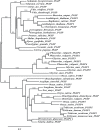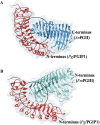Experimental and bioinformatic characterization of a recombinant polygalacturonase-inhibitor protein from pearl millet and its interaction with fungal polygalacturonases
- PMID: 24980909
- PMCID: PMC4144779
- DOI: 10.1093/jxb/eru266
Experimental and bioinformatic characterization of a recombinant polygalacturonase-inhibitor protein from pearl millet and its interaction with fungal polygalacturonases
Abstract
Polygalacturonases (PGs) are hydrolytic enzymes employed by several phytopathogens to weaken the plant cell wall by degrading homopolygalacturonan, a major constituent of pectin. Plants fight back by employing polygalacturonase-inhibitor proteins (PGIPs). The present study compared the inhibition potential of pearl millet PGIP (Pennisetum glaucum; PglPGIP1) with the known inhibition of Phaseolus vulgaris PGIP (PvPGIP2) against two PGs, the PG-II isoform from Aspergillus niger (AnPGII) and the PG-III isoform from Fusarium moniliforme (FmPGIII). The key rationale was to elucidate the relationship between the extent of sequence similarity of the PGIPs and the corresponding PG inhibition potential. First, a pearl millet pgip gene (Pglpgip1) was isolated and phylogenetically placed among monocot PGIPs alongside foxtail millet (Setaria italica). Upstream sequence analysis of Pglpgip1 identified important cis-elements responsive to light, plant stress hormones, and anoxic stress. PglPGIP1, heterologously produced in Escherichia coli, partially inhibited AnPGII non-competitively with a pH optimum between 4.0 and 4.5, and showed no inhibition against FmPGIII. Docking analysis showed that the concave surface of PglPGIP1 interacted strongly with the N-terminal region of AnPGII away from the active site, whereas it weakly interacted with the C-terminus of FmPGIII. Interestingly, PglPGIP1 and PvPGIP2 employed similar motif regions with few identical amino acids for interaction with AnPGII at non-substrate-binding sites; however, they engaged different regions of AnPGII. Computational mutagenesis predicted D126 (PglPGIP1)-K39 (AnPGII) to be the most significant binding contact in the PglPGIP1-AnPGII complex. Such protein-protein interaction studies are crucial in the future generation of designer host proteins for improved resistance against ever-evolving pathogen virulence factors.
Keywords: Computational mutagenesis; PGIPs; PGs; Phaseolus vulgaris; electrostatic surface potential; inhibition studies; pearl millet; protein modelling and docking..
© The Author 2014. Published by Oxford University Press on behalf of the Society for Experimental Biology.
Figures






Similar articles
-
Immuno-affinity purification of PglPGIP1, a polygalacturonase-inhibitor protein from pearl millet: studies on its inhibition of fungal polygalacturonases and role in resistance against the downy mildew pathogen.Mol Biol Rep. 2015 Jun;42(6):1123-38. doi: 10.1007/s11033-015-3850-5. Epub 2015 Jan 18. Mol Biol Rep. 2015. PMID: 25596722
-
Comparative study of protein-protein interaction observed in PolyGalacturonase-Inhibiting Proteins from Phaseolus vulgaris and Glycine max and PolyGalacturonase from Fusarium moniliforme.BMC Genomics. 2009 Dec 3;10 Suppl 3(Suppl 3):S19. doi: 10.1186/1471-2164-10-S3-S19. BMC Genomics. 2009. PMID: 19958482 Free PMC article.
-
A single amino-acid substitution allows endo-polygalacturonase of Fusarium verticillioides to acquire recognition by PGIP2 from Phaseolus vulgaris.PLoS One. 2013 Nov 19;8(11):e80610. doi: 10.1371/journal.pone.0080610. eCollection 2013. PLoS One. 2013. PMID: 24260434 Free PMC article.
-
Novel biotechnological strategies to combat biotic stresses: polygalacturonase inhibitor (PGIP) proteins as a promising comprehensive option.Appl Microbiol Biotechnol. 2020 Mar;104(6):2333-2342. doi: 10.1007/s00253-020-10396-3. Epub 2020 Jan 27. Appl Microbiol Biotechnol. 2020. PMID: 31989226 Review.
-
Polygalacturonase-inhibiting protein (PGIP) in plant defence: a structural view.Phytochemistry. 2006 Mar;67(6):528-33. doi: 10.1016/j.phytochem.2005.12.025. Epub 2006 Feb 3. Phytochemistry. 2006. PMID: 16458942 Review.
Cited by
-
Molecular and Functional Characterization of a Polygalacturonase-Inhibiting Protein from Cynanchum komarovii That Confers Fungal Resistance in Arabidopsis.PLoS One. 2016 Jan 11;11(1):e0146959. doi: 10.1371/journal.pone.0146959. eCollection 2016. PLoS One. 2016. PMID: 26752638 Free PMC article.
-
An update on polygalacturonase-inhibiting protein (PGIP), a leucine-rich repeat protein that protects crop plants against pathogens.Front Plant Sci. 2015 Mar 20;6:146. doi: 10.3389/fpls.2015.00146. eCollection 2015. Front Plant Sci. 2015. PMID: 25852708 Free PMC article. Review.
-
Molecular evidence for the involvement of a polygalacturonase-inhibiting protein, GhPGIP1, in enhanced resistance to Verticillium and Fusarium wilts in cotton.Sci Rep. 2017 Jan 12;7:39840. doi: 10.1038/srep39840. Sci Rep. 2017. PMID: 28079053 Free PMC article.
-
Immuno-affinity purification of PglPGIP1, a polygalacturonase-inhibitor protein from pearl millet: studies on its inhibition of fungal polygalacturonases and role in resistance against the downy mildew pathogen.Mol Biol Rep. 2015 Jun;42(6):1123-38. doi: 10.1007/s11033-015-3850-5. Epub 2015 Jan 18. Mol Biol Rep. 2015. PMID: 25596722
References
-
- Abu-Goukh AA, Greve LC, Labavitch JM. 1983. Purification and partial characterization of “Barlett” pear fruit polygalacturonase inhibitors. Physiological Plant Pathology 23, 111–122
-
- Abu-Goukh AA, Labavitch JM. 1983. The in vivo role of “Bartlett” pear fruit polygalacturonase inhibitors. Physiological Plant Pathology 23, 123–135
-
- Ahsan N, Yoon HS, Jo J. 2005. Molecular cloning of a BcPGIP cDNA from Brassica campestris and its expression to several stresses. Plant Science 169, 1081–1089
-
- Anisimova M, Gascuel O. 2006. Approximate likelihood-ratio test for branches: a fast, accurate, and powerful alternative. Systematic Biology 55, 539–552 - PubMed
-
- Anthon GE, Barrett DM. 2002. Determination of reducing sugars with 3-methyl-2-benzothiazolinonehydrazone. Analytical Biochemistry 305, 287–289 - PubMed
Publication types
MeSH terms
Substances
LinkOut - more resources
Full Text Sources
Other Literature Sources

